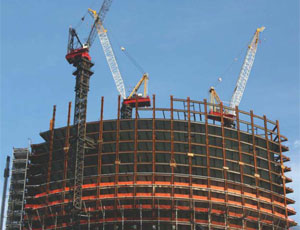The storm clouds over the New York region’s construction industry had formed in late fall 2009 as project backlogs emptied and new jobs were few on the horizon. But that bleak juncture is when some general contractors and construction managers geared up for investments – even some that escaped them during the dizzying market boom of recent years.

For Structure Tone, a decision to diversify its expertise was part of a long-term strategy – one the market bust didn’t deter, says Robert Mullen, CEO of the New York-based construction management firm, which last year did more than $1.7 billion worth of work in the region. In November, the multi-affiliate firm announced its absorption of Philadelphia’s L.F. Driscoll, a $600 million contractor specializing in the health care market.
Like many companies that seem to be weathering the harsher market, Structure Tone is hewing to plans built for good times and bad, Mullen says. “It would be much more difficult in the current environment had we not embarked on diversification efforts,” he says.
Taking a long view means knowing “the pendulum swings both ways,” says Angelo Del Russo, CEO of Del-Sano Contracting of Union, N.J., a contractor that handled $39.4 million in work in 2009. “While you may have a busy time for three or four years, you have to plan for when it’s going to be lean,” he adds. “You don’t want to be too far in debt or have high fixed costs or spend for travel or expenses far above the standard. And you have to make sure everyone has a job that’s productive.”
That doesn’t mean prepared contractors can ignore the downturn. But they shouldn’t slam on the brakes. “You can’t overreact to a difficult market,” Mullen says. “You have to be smart and certainly have to pull the reins in. Maybe you’re not spending dollars on certain things you used to, but you also want to invest dollars and resources and time to build better [operations].”
In that vein, some construction firms are seeking ways to make improvements that are overlooked in busy times. One example is professional training, says Diane Harp Jones, CEO and executive v.p. of the American Institute of Architects Connecticut chapter. “The entire design and construction industry has more time on its hands at the moment,” she adds.
Another tack is spending more time with clients to focus on value-added services, says Thomas Durels, CEO of Malkin Construction, a contractor based in Stamford, Conn., that had $60 million worth of work in 2009. “We’re spending a lot of time with clients on budgeting, looking at cost alternatives and creative solutions,” he adds.
And of course, contractors should stay on their game. The market may offer fewer prospects, but the number of bidders vying for each one has mushroomed, says Mike Kolakowski, CEO of KBE Building Corporation, a contractor based in Farmington, Conn., that had $157 million in 2009 volume. “There are opportunities, but there is extreme competition,” he adds. “The pricing structure is very competitive, very aggressive. And we’re making sure we are being proactive in our client relationships, both existing as well as new.”
A Wrecked Landscape Contractors see the damage across many sectors, with few exceptions. The high-rise residential and office markets are particularly deflated, while the few areas with activity – health care, higher education, and government-funded projects – are attracting gobs of bidders.
“We’re in half a dozen markets extensively, and all of them have been impacted, some more so than others,” says Kolakowski, whose firm focuses on the buildings market.
On the heavy construction side, 2009 saw several big-scale projects continuing, says Denise Richardson, managing director of the General Contractors Association, which represents New York region civil contractors. “Our members...


Post a comment to this article
Report Abusive Comment